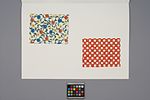Paper
About this object
History of use
Papermaking originated on the Asian mainland and spread to Japan by 1500 years ago. For centuries Japan has produced the greatest quantity and variety of handmade paper or washi in the world. Traditionally, papermaking was a family or community enterprise which thrived in mountain farming communities where cold, pure water and wild bast fibre shrubs, such as mulberry, are plentiful. Washi is an important cultural symbol and holds a place in nearly every aspect of Japanese life. It is also a significant aspect of both Shinto and Buddhist rites and customs. Katazomegami is used to make illustrated books, cards, folding fans, postcards, calendars, bookplates, matchboxes, and other decorative applications. This paper was first developed by Keisuke Serizawa in 1935. He adapted a textile dyeing technique.
Narrative
This is part of the Tesukiwashi Taikan, a collection of handmade paper published, in an edition of 1000 copies, in Tokyo as a project to commemorate the centennial of Mainchi Newspapers and to preserve Japanese handmade paper. A collection on this scale had not been made before. This collection consists of 5 boxes of mounted and labelled samples with an explanatory book in 4 of the boxes. The text is in Japanese and with less detail, in English. Compiled and edited by a special editorial staff of scholars. Published by the Mainchi Newspapers of Tokyo, Japan.
Cultural context
sample
Physical description
Washi samples mounted vertically on white, labelled and folded paper with 3-pointed leaf above scrolled 'm' watermark. Mounting paper folds in half with rectangular windows over 2 rectangular stenciled samples. Sample at top left is of 6 petalled flowers with swirling green arabesque-like leaves between, all on a white ground. Centre of flowers are darker circles, or green on yellow with white centre and white lines out to petals. Sample at bottom right is a red/orange on white checkerboard pattern. Every other horizontal row has 2 different alternating designs on the red/orange. These are 6 white dots around a centre dot with yellow circle over part; black cross in a white circle with a white dot at centre; red triangles with dot top and bottom and white triangles left and right; white 'x' with 4 white dots between lines.
Categories
Materials
Mulberry Mucilage Pigments Paste / printed machine made paper
